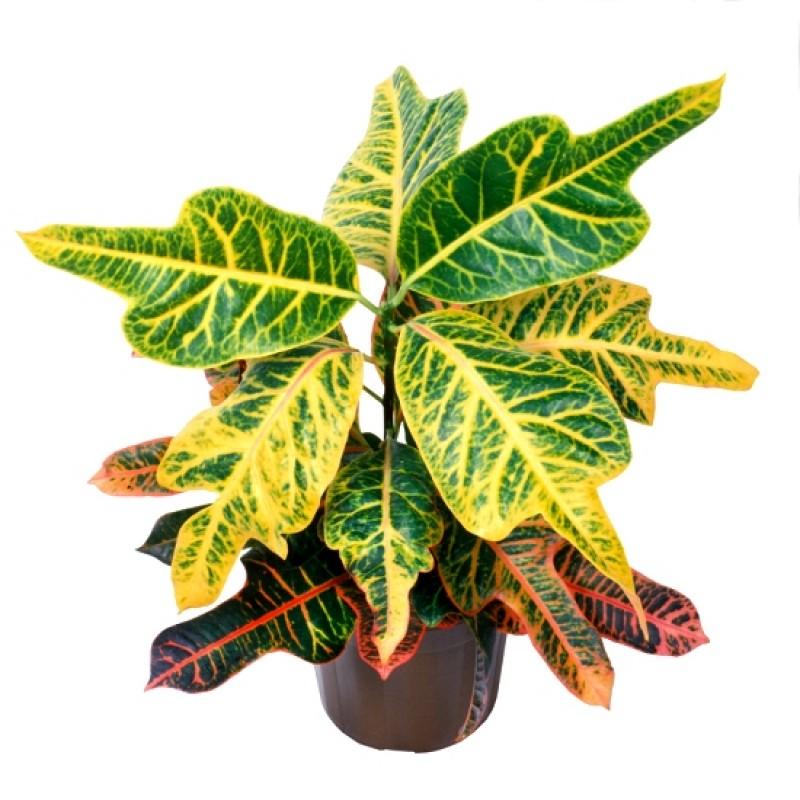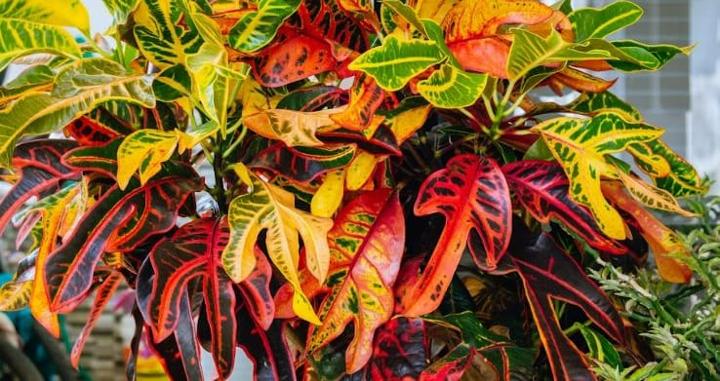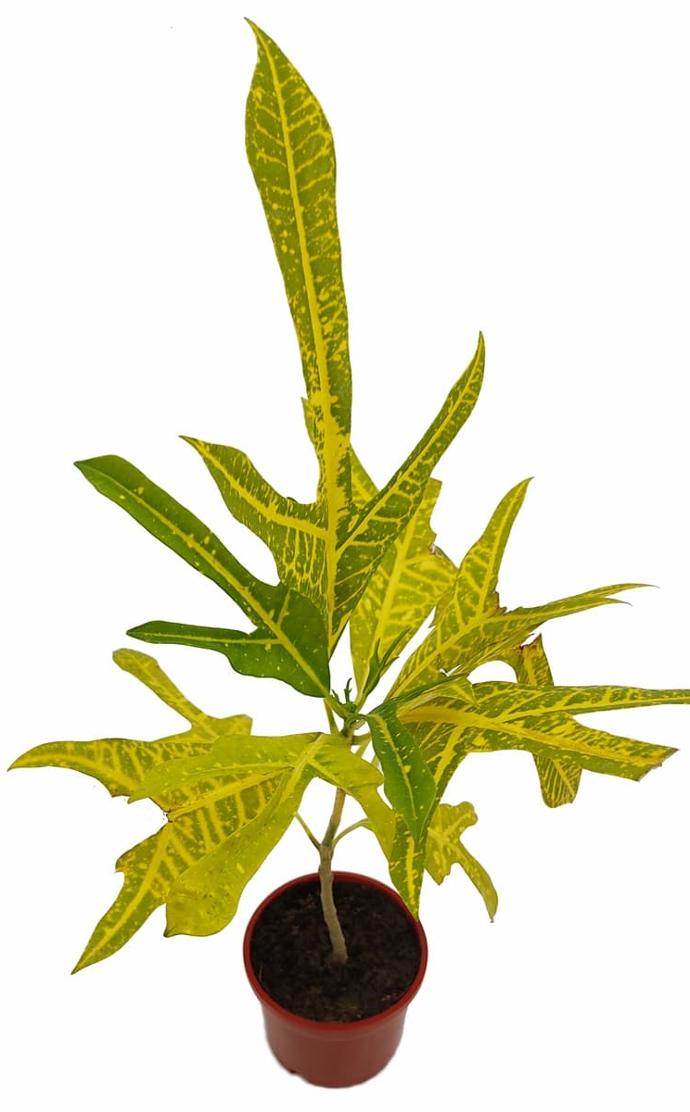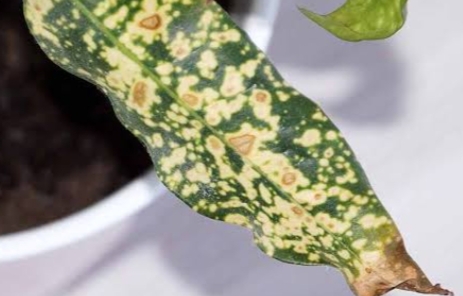Duck Foot Croton Plant
Duck Foot Croton, a variety of Croton, thrives in well-draining soil and bright, indirect light. Keep the soil consistently moist but not waterlogged. Pruning helps maintain a compact shape and enhances the ornamental appearance of its unique foliage.

Habit
Shrub
Height
30 to 90 cm
Growth
Fast
Soil
Well-drained, peat-based
Shade
Full Sun to partial shade
Moisture
Moist
Edible
No
Medicinal
No
Origin
Southeast Asia
Climatic Condition
Warm, Humid
Temperature (°)
18 to 30
Humidity (%)
60 to 90 %
Potting media
Peat-perlite mix
Fertilizers
Organic fertilizers
Watering
Moderate
Plant Weight
200-500 g
Flowering Time
Rarely flowers
Soil Ph level
5.5 to 6.5
Water Ph level
6.0 to 7.0
Soil EC
0.3 to 1.2
Yield Per Plant
Ornamental plant
NPK ratio
10:10:10
life Span
Perennial
Health Benefits
Decorative foliage plant, air purifier
Suggested Grow Media or Potting Mix ?
50% peat moss, 30% perlite, 20% compost
Suggested Fertigation/Fertilizers
Fertilize every 2 weeks with a balanced fertilizer.
Common Diseases and Remedies
Anthracnose
Leaves get discoloured and cause dark lesions on the leaves
Use well drained potting mix, for good drainage.
What Is A Duck Foot Croton?
"Duckfoot croton" refers to a variety of the croton plant (Codiaeum variegatum) that is characterized by a unique leaf shape that resembles a duck's foot. These plants are known for their colorful foliage, which is a mix of bright shades of red, yellow, orange, and green. Duckfoot crotons are popular as decorative houseplants or as additions to outdoor landscapes because of their striking appearance and relatively low maintenance. Codiaeum variegatum The duckfoot croton plant, also known as 'duckfoot', is a variety of the croton plant species. It gets its name from its distinctive leaf shape, with wide, flat leaves radiating from a central point, resembling a duck's foot. This plant is prized for its colorful foliage, which features a combination of red, yellow, orange, and green, adding a vibrant atmosphere to indoor and outdoor spaces.

What are the different types of duck foot croton plant?
There are several varieties of Duckfoot Croton plants, each with its unique characteristics:
1. Codiaeum variegatum 'Dreadlocks':-
This variety has narrow, elongated leaves with twisted or curled edges, resembling dreadlocks. It often features a mix of red, orange, and yellow hues in its foliage.
2. Codiaeum variegatum 'Gold Dust':-
'Gold Dust' Duckfoot Croton is known for its bright yellow-green foliage speckled with small gold spots or flecks, creating a dazzling display of color.
 How to care for duck foot croton plant?
How to care for duck foot croton plant?
1.Location:
Duckfoot Croton plants are native to tropical regions such as Southeast Asia, Indonesia, and the Pacific Islands. In their natural habitat, they thrive in warm, humid climates with ample sunlight. These plants can be found growing in tropical forests, along riverbanks, and in other areas with rich, well-draining soil.
2.Sunshine:
Duckfoot Croton plants thrive in bright, indirect sunlight. They require plenty of natural light to maintain their vibrant foliage colors and promote healthy growth. However, direct sunlight can scorch their leaves, so it's essential to protect them from harsh afternoon sun.
3. Soil:
Duckfoot Croton plants prefer well-draining soil that is rich in organic matter. A high-quality potting mix designed for tropical plants or a blend of equal parts peat moss, perlite, and compost works well. This type of soil provides the right balance of moisture retention and drainage, preventing waterlogged conditions that can lead to root rot.
4.Hydration:
The hydration of a Duck Foot Croton plant involves providing it with an adequate amount of water to support its growth and health. Duck Foot Croton plants, like many other plants, require regular watering to thrive. However, it's essential not to overwater them, as they are susceptible to root rot. The soil should be kept evenly moist but not waterlogged. Watering when the top inch of soil feels dry to the touch is a good rule of thumb. Additionally, it's crucial to ensure proper drainage in the pot to prevent waterlogging.
 5.Nourishment:
5.Nourishment:
Nourishing a Duck Foot Croton plant involves providing it with essential nutrients to support its growth and development. This can be achieved through regular fertilization with a balanced, water-soluble fertilizer formulated for houseplants. It's recommended to dilute the fertilizer to half-strength and apply it every 4-6 weeks during the growing season (spring and summer).
6.Issues:
Some common issues with Duck Foot Croton plants include:
1. Leaf Dropping: Dropping leaves can occur due to overwatering, underwatering, or sudden changes in environmental conditions. It's essential to maintain consistent watering and provide appropriate light levels.
2. Leaf Browning or Yellowing: Browning or yellowing leaves can result from various factors such as nutrient deficiencies, overfertilization, pests, or diseases. Proper fertilization, pest management, and maintaining optimal growing conditions can help address these issues.
3. Pests: Duck Foot Croton plants may be susceptible to pests such as spider mites, mealybugs, or scale insects. Regular inspection and appropriate pest control measures, such as insecticidal soap or neem oil, can help manage pest infestations.
What are the benefits of Duck Foot Croton ?
Like many other houseplants, the duck foot croton helps improve indoor air quality by absorbing pollutants such as formaldehyde, benzene, and trichloroethylene, thus contributing to a healthier living or working environment.It's relatively easy to care for, requiring moderate watering and indirect sunlight. This makes it suitable for both experienced and novice gardeners looking to add a touch of greenery to their spaces.

FAQs about growing duck foot croton plant
1.What are the care requirements for the duck foot croton plant?
The care requirements for Duck Foot Croton plants include:
Light, Watering, Humidity, temperature, soil , fertilisation
2.How often should I water duck foot croton plant?
You should water your Duck Foot Croton plant when the top inch of soil feels dry to the touch. Typically, this means watering approximately once a week, but it can vary depending on factors like temperature, humidity, and the size of the pot. Always check the soil moisture before watering to avoid overwatering, which can lead to root rot, or underwatering, which can cause the plant to wilt. Adjust the watering frequency accordingly based on the specific needs of your plant and its environment.
3.What kind of light does the duck foot croton plant prefer?
The Duck Foot Croton plant prefers bright, indirect sunlight. It thrives in well-lit areas but should be protected from direct sunlight, especially during the hottest part of the day. Placing it near a window where it can receive bright, filtered light or using sheer curtains to diffuse direct sunlight can help maintain its health and vibrant foliage. Avoid placing it in low-light conditions, as this can lead to leggy growth and reduced foliage coloration.
4.What are the common pests and diseases that affect the duck foot croton plant?
Common pests that can affect Duck Foot Croton plants include:
1. Spider mites: These tiny pests can cause webbing on the leaves and yellowing or stippling of the foliage.
2. Aphids: Aphids feed on the sap of plants, causing distorted growth, yellowing leaves, and the secretion of sticky honeydew.
3. Mealybugs: Mealybugs are small, white, cottony insects that cluster on the undersides of leaves and along stems. They can cause yellowing, wilting, and leaf drop.
5.Can duck foot croton plants be grown indoors or outdoors?
Duck Foot Croton plants can be grown both indoors and outdoors, depending on your climate and preferences.
Indoors: They make excellent houseplants, thriving in bright, indirect sunlight. They are well-suited for indoor environments with stable temperatures and high humidity levels. Just ensure they receive enough light and proper care to maintain their vibrant foliage.


